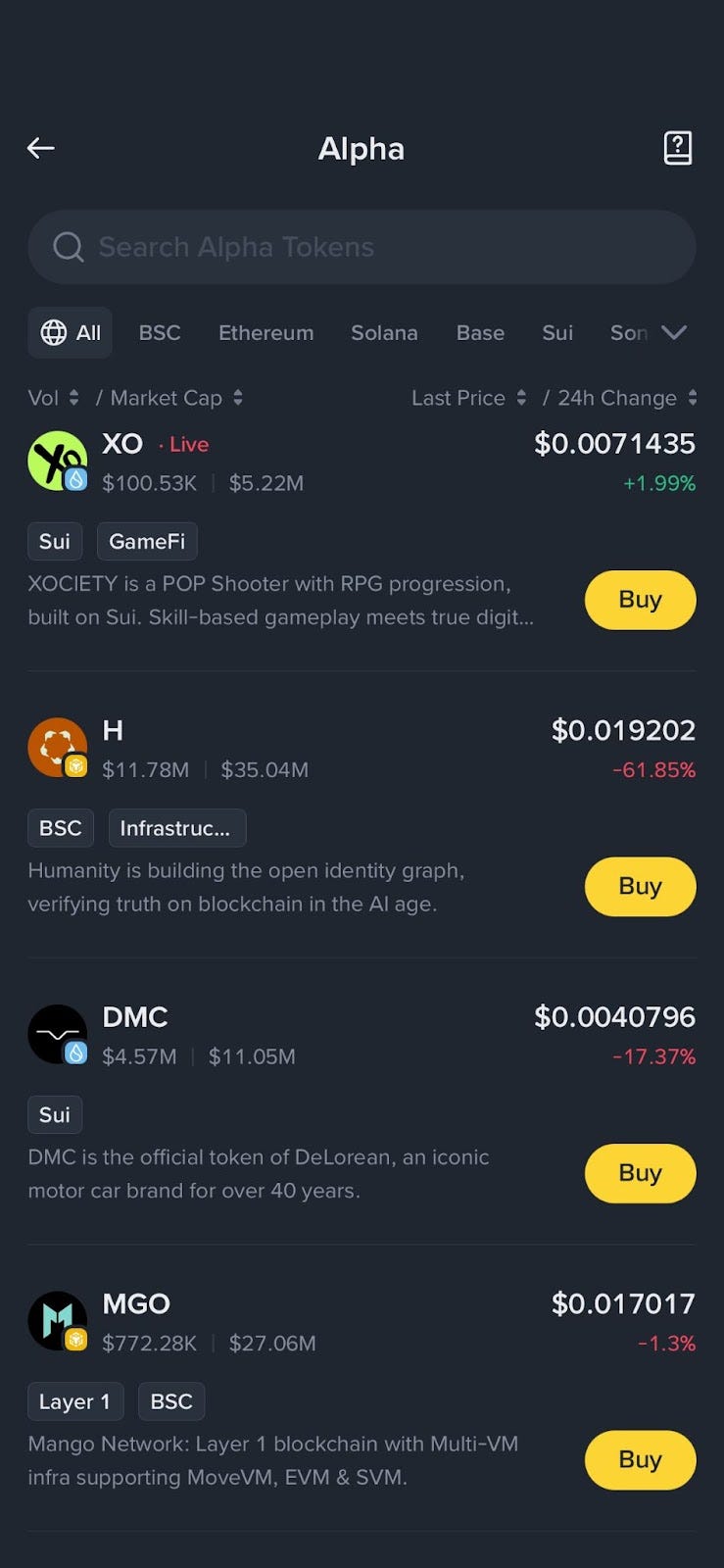This report, written by Tiger Research, analyzes why major centralized exchanges like Bybit, Binance, and Coinbase are entering the DeFi space and their strategies.
TL;DR
Strategic Differentiation: Binance offers a retail-focused on-chain service aimed at lowering Web3 entry barriers. Bybit has launched an independent platform (ByReal) to deliver CEX-level liquidity on-chain. Coinbase operates a dual-track model targeting both retail and institutional users.
Why CEXs Are Moving On-Chain: As early-stage tokens increasingly debut on DEXs, centralized exchanges face delayed listings due to regulatory review—losing out on volume and revenue. On-chain services allow them to engage with early token flows and retain users without formal listings.
The Future of CeDeFi: Platform boundaries are blurring. Exchange tokens are evolving from fee-discount utilities into core assets that bridge centralized and decentralized ecosystems. Few DeFi protocols may be absorbed into larger CEX-led networks, accelerating the formation of an integrated hybrid market.
1. Too Big to Miss: CEXs Move to On-Chain
Binance’s recent initiative, Binance Alpha, has emerged as a focal point in the market. Operated by the Binance team, Alpha functions as a DeFi-based listing platform that enables retail users to access early-stage tokens more quickly than through traditional exchange channels. This significantly improves token accessibility and engagement, especially through mechanisms like Alpha Points, which facilitate targeted airdrops to users.
However, the model has not been without controversy. Several tokens listed via Alpha have experienced sharp price declines shortly after launch, sparking debate around the program's structure and intent. Despite mixed assessments, one trend is evident: centralized exchanges are no longer passive observers of the DeFi ecosystem—they are now active participants.
This shift is not limited to Binance. Other major platforms are also moving on-chain. Bybit, for example, recently announced ByReal, a Solana-based DeFi platform. Coinbase also revealed the plan to integrate on-chain services directly into its app. These developments point to a broader structural transition underway across the exchange sector.
The key question is: why are centralized exchanges—long supported by stable, revenue-generating business models—entering the inherently volatile DeFi market? This report analyzes the strategic rationale behind that shift and examines the market dynamics driving this evolution.
2. The Current State of CEXs Entering DeFi: What Are They Actually Building?
Before analyzing the strategic motivations behind centralized exchanges entering the DeFi space, it's important to first clarify what they are actually building. While these efforts are often grouped under the broad trend of "CeDeFi" (Centralized–Decentralized Finance), the implementation varies significantly across platforms.
Bybit, Coinbase, and Binance have each taken distinct approaches—with differences spanning architecture, asset custody models, and user experience. Understanding these divergences is essential to evaluating their respective strategies.
2.1. Bybit’s ByReal: Delivering CEX-Level Liquidity via an Independent DEX
On June 14, Bybit announced ByReal as an onchain extension of its exchange infrastructure. The primary objective is clear: to replicate centralized exchange–level liquidity in an on-chain environment. To achieve this, Bybit employs a hybrid design that integrates a Request-for-Quote (RFQ) system with a Concentrated Liquidity Market Maker (CLMM) model.
The RFQ mechanism allows users to request quotes from multiple brokers before executing a trade, enabling price optimization through professional market makers. The CLMM model concentrates liquidity around actively traded price ranges, improving capital efficiency and minimizing slippage—key factors in approximating a CEX-like trading experience on-chain.
At the same time, ByReal maintains decentralization at the user level. Assets are self-custodied through Web3 wallets like Phantom, and the platform includes a token launchpad for new project issuance. It also offers yield-generating features through its Revive Vault, including Solana staking products such as $bbSOL.
Bybit’s strategic intent with ByReal is to create a parallel liquidity layer for early-stage tokens that may not meet the listing standards of its main exchange, but could thrive in a more open, community-driven setting. While the model is structurally similar to Binance Alpha, ByReal distinguishes itself by integrating launchpad capabilities and yield products into a more comprehensive service offering.
2.2. Coinbase: A Dual-Track Strategy for Retail and Institutional Users
At the State of Crypto Summit 2025, Coinbase announced plans to integrate DeFi trading directly into its main app, rather than through a standalone wallet. The core of this strategy lies in delivering a seamless user experience. By enabling DEX trades within the core application, users can access and trade thousands of tokens from the moment assets are minted—without leaving the Coinbase interface.
While DeFi access is already available through the standalone Coinbase Wallet, the company has introduced a key differentiator: Verified Pools. These pools are accessible only to KYC-verified institutional participants, offering a secure, compliant environment tailored to entities with regulatory obligations.
The result is a sophisticated dual-track strategy. Coinbase simultaneously targets retail users through smooth, integrated on-chain access, while providing a regulated, high-assurance liquidity venue for institutional actors. This allows the company to operate across both user segments without compromising on either usability or compliance.
2.3. Binance Alpha: A Retail-Centric Approach That Lowers Web3 Friction
Among the three exchanges, Binance Alpha is the most retail-oriented offering. Unlike others that emphasize decentralization, Binance prioritizes ease of use. Alpha is accessible directly through a tab in the main Binance app, allowing users to trade without leaving the familiar interface.
Although all transactions are processed on-chain, users interact with Alpha using their existing Binance accounts. There is no need to set up a separate wallet or manage seed phrases, significantly lowering the entry barrier for Web3 newcomers.
While all three platforms are converging toward CeDeFi models, their approaches differ markedly. Bybit targets DeFi-native users with a fully decentralized architecture and advanced liquidity mechanisms. Coinbase pursues a dual-track strategy that serves both retail and institutional clients through differentiated infrastructure. Binance, in contrast, focuses on mass adoption by abstracting away the complexity of Web3.
Each exchange is navigating its own trade-offs in asset custody, product curation, and integration depth—collectively shaping distinct entry points into the evolving CeDeFi landscape.
3. Strategic drivers behind the CEX pivot to DeFi
3.1. Getting early tokens without listing risk
The first reason is straightforward: CEXs want first access to hot tokens, but they can’t list them fast enough.
Most new tokens now launch directly on DEXs, where permissionless listings and viral attention drive rapid volume. CEXs, constrained by legal vetting, risk controls, or jurisdictional compliance, often can’t list those tokens immediately, even if they see clear user demand.
This delay creates a real opportunity cost. Trading volume flows to decentralized platforms like Uniswap. Listing fees are lost. And critically, users begin to associate discovery and innovation with DEXs, not CEXs.
By launching their own on-chain products, CEXs create a middle ground. Platforms like ByReal and Binance Alpha function as semi-sandboxed venues: tokens can trade without going through formal listing channels, but still within a controlled, brand-safe environment. This allows the exchange to monetize user activity early — through swap fees or token launch mechanisms — while maintaining legal distance. The exchange facilitates access, but does not take custody or endorse the asset directly.
This structure gives CEXs a path to participate in token discovery without triggering regulatory liability. They capture liquidity, generate revenue, and funnel activity back into their ecosystem — all while waiting for formal listing reviews to catch up.
3.2. Keeping users on-chain, without losing them
The second driver is rooted in user behavior. While DeFi continues to lead on token innovation and capital efficiency, it remains difficult for mainstream users to access. Most are unwilling to manually bridge assets, manage wallets, approve smart contracts, or pay unpredictable gas fees. Despite this friction, the most attractive opportunities, like trading new token launches, yield strategies, are increasingly live on-chain.
CEXs have identified this gap and are responding by embedding DeFi access directly into their own platforms. All the aforementioned CEX integrations allow users to interact with on-chain liquidity using familiar CEX interfaces. In many cases, the exchange abstracts away wallets and gas costs entirely, letting users access DeFi with the ease of a Web2 app.
This approach serves two goals. First, it prevents user churn. Traders who might have left for DEX now stay within the CEX ecosystem, even while interacting with DeFi products. Second, it strengthens platform defensibility. By owning the access layer and increasingly the liquidity layer, CEXs build network effects that extend beyond spot trading.
Over time, this translates into platform lock-in. As users become more sophisticated, many will seek cross-chain routing, yield products, and trading strategies. If a CEX owns its own DEX infrastructure, launchpad layer, and even a proprietary chain (e.g., Coinbase’s Base), it ensures that users, developers, and liquidity all remain tied to its ecosystem. Activity is tracked, monetized, and recycled — not lost to third-party protocols.
In effect, going on-chain allows CEXs to control the full lifecycle of user capital: from fiat onboarding, to DeFi exploration, to eventual listing and exit — all within a unified, revenue-generating stack.
4. The Road Ahead for CeDeFi
The on-chain expansion of major centralized exchanges marks a clear inflection point in the evolution of the crypto industry. CEXs are no longer treating DeFi as an external phenomenon—they are now building their own infrastructure or, at a minimum, securing direct access points to the user layer.
4.1. Blurring Boundaries: A New Trading Paradigm
As CEXs integrate on-chain services, the distinction between "exchange" and "protocol" is becoming increasingly irrelevant from the user’s perspective. A Bybit user trading on-chain tokens may not even realize whether they’re interacting with a decentralized protocol or a centralized interface. This convergence could significantly reshape the architecture of liquidity, product design, and user flows across the industry.
Institutional behavior will also be critical to watch—but a full-scale capital influx is unlikely in the short term. Institutions are still cautious, primarily due to unresolved risks: regulatory uncertainty, smart contract vulnerabilities, token price manipulation, and opaque governance mechanisms.
The introduction of on-chain services by exchanges does not eliminate these structural risks. In fact, some institutions may perceive exchange-mediated access to DeFi as a new layer of intermediary risk. Realistically, early experimentation will likely come from hedge funds and proprietary trading firms deploying small-scale capital. More conservative players, such as pension funds or insurance companies, are expected to remain on the sidelines for several more years. Even if they do participate, it will likely be with a cautious allocation—typically no more than 1–3% of their portfolios.
In this context, projections of “multi-billion dollar inflows” are premature. A more realistic outlook involves incremental testing in the hundreds of millions. Still, even these moderate inflows could enhance market depth and dampen volatility in meaningful ways.
4.2. The Evolving Role of Exchange Tokens
As exchanges expand their on-chain offerings, the function of native exchange tokens is also expected to evolve. Holding a certain amount of these tokens may enable on-chain fee discounts, or unlock yield opportunities via staking or liquidity incentives. These shifts are likely to introduce new utility—and new volatility—into exchange token valuations.
Currently, Binance is the only major platform demonstrating clear and sustained utility for its native token (BNB), which plays an active role across multiple services. Most other exchange tokens remain limited to basic fee discounts.
As CeDeFi infrastructure matures, this status quo is poised to change. With exchanges operating integrated on- and off-chain platforms, their native tokens will serve as the connective tissue between the two domains. Users may need to hold exchange tokens to participate in staking, launchpools, or gain early access to new listings—both centralized and decentralized.
This functional expansion positions exchange tokens as more than utility assets—they become core assets within a vertically integrated ecosystem. Exchanges with existing tokens may choose to significantly enhance utility, while those without tokens may consider launching new ones to support DeFi-linked services. This is especially likely for platforms developing their own blockchains or differentiated DeFi layers.
In short, exchange tokens are evolving from simple fee instruments into strategic assets central to user retention, protocol integration, and cross-platform capital flow.
4.3. Convergence in Motion: A New Competitive Landscape
CEXs' push into on-chain services is not merely a defensive maneuver. It reflects a proactive bet on the future of the crypto ecosystem. Rather than treating DeFi as a threat, exchanges appear to view it as an adjacent domain to be integrated—or even absorbed.
The most likely scenario is convergence. Major exchanges will increasingly operate semi-decentralized networks, while standalone DeFi protocols may find themselves dependent on, or integrated into, these growing ecosystems. The result could be a realignment of power and liquidity, with CEX-led platforms becoming gravitational centers for DeFi activity.
This trend may lead to a more unified market structure where liquidity flows freely between centralized and decentralized environments. Users will be able to choose the blend of trust, transparency, and convenience that suits their preferences. The competitive landscape is shifting, and Bybit’s launch of ByReal may well be an early signal of this hybrid future taking shape.
🐯 More from Tiger Research
Read more reports related to this research.Disclaimer
This report has been prepared based on materials believed to be reliable. However, we do not expressly or impliedly warrant the accuracy, completeness, and suitability of the information. We disclaim any liability for any losses arising from the use of this report or its contents. The conclusions and recommendations in this report are based on information available at the time of preparation and are subject to change without notice. All projects, estimates, forecasts, objectives, opinions, and views expressed in this report are subject to change without notice and may differ from or be contrary to the opinions of others or other organizations.
This document is for informational purposes only and should not be considered legal, business, investment, or tax advice. Any references to securities or digital assets are for illustrative purposes only and do not constitute an investment recommendation or an offer to provide investment advisory services. This material is not directed at investors or potential investors.
Terms of Usage
Tiger Research allows the fair use of its reports. ‘Fair use’ is a principle that broadly permits the use of specific content for public interest purposes, as long as it doesn't harm the commercial value of the material. If the use aligns with the purpose of fair use, the reports can be utilized without prior permission. However, when citing Tiger Research's reports, it is mandatory to 1) clearly state 'Tiger Research' as the source, 2) include the Tiger Research logo. If the material is to be restructured and published, separate negotiations are required. Unauthorized use of the reports may result in legal action.
















